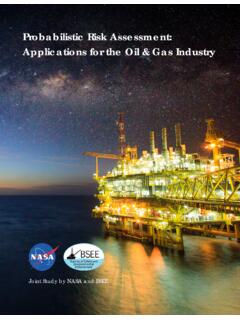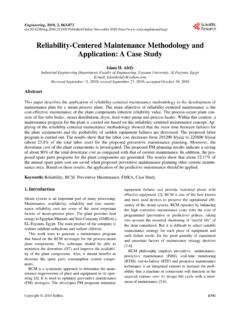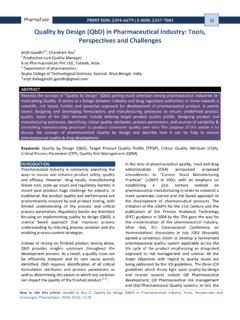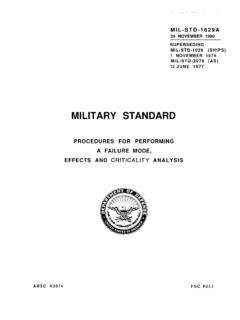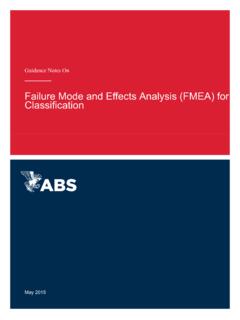Transcription of Failure Analysis - University of Delaware
1 Failure Analysis MethodsWhat, Why and HowMEEG 466 Special Topics in DesignJim GlanceySpring, 2006 Failure Analysis Methods Every product or process has modes of Failure . An Analysis of potential failures helps designers focus on and understand the impact of potential process or product risks and failures. Several systematic methodologies have been develop to quantify the effects and impacts of failures. Failure Analysis Methods ..Why perform Failure Analysis ? Product Development: Prevent product malfunctions. Insure product life. Prevent safety hazards while using the product. Process Development: Insure product quality Achieve process reliability Prevent customer dissatisfaction Prevent safety or environmental hazardsCommon Failure Analysis Techniques Cause-Consequence Analysis Checklist Event Tree Analysis Failure Modes & Effects Analysis (FMEA) Failure Modes, Effects and criticality Analysis ( fmeca ) Fault Tree Analysis (FTA) Hazard & Operability Analysis (HAZOP) Human Reliability Preliminary Hazard Analysis (PHA) Relative Ranking Safety Review What-If / Checklist Analysis What-If AnalysisFor the purpose of this class, two common but fundamentally different techniques will be presented in detail:1.
2 Failure Modes Effects Analysis (FMEA)2. Fault Tree AnalysisPart 1: Failure Modes effect Analysis Failure Modes & Effects Analysis (FMEA) Tabulation of equipment/components and their associated single point Failure modes, consequences and safeguards. Identification/assessment of risk is derived from looking at each component (or machine in the case of multi-unit manufacturing). This is commonly referred to as a bottom-up Tire-Supports Weight-Traction -Cornering-Smooth RideFlat -Stranded-Loose ControlSpare TireIn TrunkAcceptable as isGas TankHolds fuel2 Simple Example: Car-Empty-Blows up-Stall-Car Destroyed-Fuel Gage-Locate awayfrom EngineAcceptableas isImplementing FMEAAn FMEA can be implemented using a hardware or functional approach, and often due to system complexity, be performed as a combination of the two = loss of a component Functional = loss of a function or featureFailures Need to understand failures which can be any of the following: Failure is any loss that interrupts the continuity of production.
3 Failure is a loss of asset availability. Failure is the unavailability of equipment. Failure is a deviation from the status quo. Failure is not meeting target expectations. Failure is any secondary defectFailures .. Failures can be: pump not working seized valve broken wire software crash system down reactor melt down no money in a checking account (inevitable for college student)Failures .. Defining the possible (and relevant) failures is the key for the Analysis to produce meaningful results. For instance, if all we care about are failures that cause injuries or death, then the Analysis would be much different than one that was interested in economical Procedure Review and understand product or process design; breakdown into components (product) or steps (process). Brainstorm modes of Failure .
4 Rate the severityof each effect of Failure . Rate the likelihood of occurrencefor each Failure . Rate the likelihood of detectionfor each cause of Failure ( likelihood of detecting the problem before it reaches the customer or operator). Compute the Risk Priority Number, RPN = Severity x Occurrence x Detection Implement corrective actions to minimize the occurrence of the more significant Failure modes ( the highest RPN s). Re-assess the product or process by another cycle of FMEA after the actions have been completed. Perform regular (re)assessments of failures as needed. FMEA TableExample: Hydraulic Hose Failure Severity, Occurance and Detection ratings are based on a 1 = low to 10 = high scale. The FMEA results clearly show the greatest risk is associated with over-pressure Failure , and the lowest risk is due to weathering-related Failure .
5 The excel template shown is above is available at: ~ 2: Fault Tree AnalysisFault Tree Analysis (FTA) Graphical model that displays the various combinations of equipment failures and human errors that can result in the main system Failure of interest. Identification/assessment of risk is derived by first identifying faults/hazards. A top down FAULT An abnormal undesirable state of a system or a system element* induced 1) by presence of an improper command or absence of a proper one, or 2) by a Failure (see below). All failures cause faults; not all faults are caused by failures. A system which has been shut down by safety features has not faulted. Failure Loss, by a system or system element*, of functional integrity to perform as intended, , relay contacts corrode and will not pass rated current closed, or the relay coil has burned out and will not close the contacts when commanded the relay has failed; a pressure vessel bursts the vessel fails.
6 Fault Tree ExampleFault Tree Construction Each node in the tree can be represented by a combination of events that cause the occurrence of the event, by means of logic gates Each gate has inputs and outputs An input can be a basic event or an output of another gate The development of a fault tree model relies on the analystanalyst s understandings understandingof the system being analyzed It is very importantvery importantto understand the system first in order to build a unbiased fault treeLogic (Boolean) GatesFTA StructureIdentifying TOP Events Explore historical records (own and others). Look to energy sources. Identify potential mission Failure contributors. Development what-if scenarios. Use shopping lists. FTA ExampleConsider lamp failing to illuminate when the fluid level is too Tree Constraints and Shortcomings Undesirable events must be foreseen and are only analyzed singly.
7 All significant contributors to fault/ Failure must be anticipated. Each fault/ Failure initiator must be constrained to two conditional modes when modeled in the tree. Initiators at a given Analysis level beneath a common gate must be independent of each other. Events/conditions at any Analysis level must be true, immediate contributors to next-level events/conditions. Each Initiator s Failure rate must be a predictable FTA vs. FMEA

